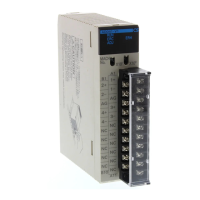53
blocks to be combined, starting each block with LOAD or LOAD NOT, and
then to code the logic block instructions which combine them. In this case,
the instructions for the last pair of blocks should be combined first, and then
each preceding block should be combined, working progressively back to the
first block. Although either of these methods will produce exactly the same
result, the second method, that of coding all logic block instructions together,
can be used only if eight or fewer blocks are being combined, i.e., if seven or
fewer logic block instructions are required.
The following diagram requires AND LOAD to be converted to mnemonic
code because three pairs of parallel conditions lie in series. The two options
for coding the programs are also shown.
00000 00002 00004
00001 00003 00005
00500
Address Instruction Operands Address Instruction Operands
00000 LD 00000
00001 OR NOT 00001
00002 LD NOT 00002
00003 OR 00003
00004 AND LD —
00005 LD 00004
00006 OR 00005
00007 AND LD —
00008 OUT 00500
00000 LD 00000
00001 OR NOT 00001
00002 LD NOT 00002
00003 OR 00003
00004 LD 00004
00005 OR 00005
00006 AND LD —
00007 AND LD —
00008 OUT 00500
Again, with the method on the right, a maximum of eight blocks can be com-
bined. There is no limit to the number of blocks that can be combined with
the first method.
The following diagram requires OR LOAD instructions to be converted to
mnemonic code because three pairs of series conditions lie in parallel to
each other.
00000 00001
00002 00003
00040 00005
00501
The first of each pair of conditions is converted to LOAD with the assigned bit
operand and then ANDed with the other condition. The first two blocks can
be coded first, followed by OR LOAD, the last block, and another OR LOAD;
Basic Ladder Diagrams Section 4-3

